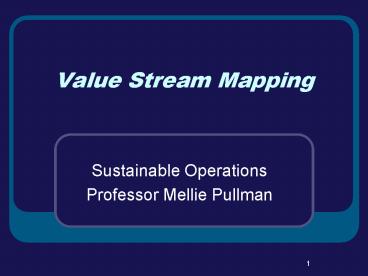Value Stream Mapping - PowerPoint PPT Presentation
1 / 21
Title:
Value Stream Mapping
Description:
Value Stream Mapping Sustainable Operations Professor Mellie Pullman * * What s in it for you? A significant tool for improving any process, Key tool for ... – PowerPoint PPT presentation
Number of Views:428
Avg rating:3.0/5.0
Title: Value Stream Mapping
1
Value Stream Mapping
- Sustainable Operations
- Professor Mellie Pullman
2
Whats in it for you?
- A significant tool for improving any process,
- Key tool for prototyping an idea before going
into action - Designing a new operation, examining needed
resource inputs (information, people, materials) - Relevant for existing operation or new operation
- Evaluating each step to see if is adding value or
generating waste - Determining the costs of inputs and outputs at
each step - Puts new eyes on the process when you walk
through and document through your map
3
Value Stream Mapping Analysis
- Purpose to describe a process visually to find
ways of improving the current process. - Find repetitive operations
- Identify potential bottlenecks
- Describe directions and distances of flows
(people, material and information) - Look at resource use and minimums
- Create better value reduce waste
4
Detailed Process Map
- Identifies the specific activities that make up
the process. Basic steps are - Identify the entity that will serve as your focal
point - Customer?
- Order, item, proposal, event package, or similar
concept that passes through a series of process
steps. - Identify clear boundaries, starting and ending
points, and lines of demarcation between
customer, order, and other relevant information
flows. - Keep it simple
- Does this detail add any insight?
- Do we need to map every exception condition?
5
Typical Mapping Symbols
or
Operation (task or work activity)
Inspection
Decision point (typically requires a yes or
no)
Document or order created
Delay
Storage
Transportation Move Materials, customers or
employees
6
Other Value-stream Map symbols
Identifies improvement opportunity
Truck Shipment
External Source (suppliers Customers)
Process
Process Descriptor
Inputs
Outputs
7
Map Example Lean CleanFinding the current
state of resource use and plan for reducing it
- Green Suppliers want to understand their resource
and toxic material use versus the minimum
required at each process (currently done at
sustainably focused companies like New Belgium
Brewery)
8
1) Start Big Look at the major process steps
9
2. Identify a key resource that you would like to
track (water, energy, GGE or carbon, labor, local
economy contribution, value-add time)
Comparing Usage to Needs Visually (bottom of map)
10
Example Water used versus needed
11
3. Focus on an opportunity area for improvement
or Innovation for new concept developers
12
4. Create a process map focusing specifically on
that opportunity area
13
5. Visualize an Improve Future State for the
opportunity areas (brainstorm about how to do
things differently)
14
Value add LensDistinguish between Value-Add and
Non Value-Add Process Step
- Value Add (VA)
- Business Non-value-add (BNVA)
- Non-value-add (NVA)
15
Value Add Steps
- Work that contributes to what your customers want
out of your product or service - Cooking a meal
- Measuring Cutting Material
- A more sustainable and better life
- Does it meet these criteria?
- Adds a desired function, form, or feature to the
product or service - Enables a competitive advantage (reduced price,
faster delivery, socially sustainable) - Includes an activity that a customer would be
willing to pay for or would not prefer our
competitors if he/she knew we did this task and
they did not.
16
Business Non-Value Add
- Activities that your customer doesnt want to pay
for (it does not increase value in their eyes)
but are required for some reason - Accounting, legal, regulatory
- Is task required by law or regulation?
- Does task reduce financial/liability risk?
- Does task support financial requirements?
- Does process break down if task is removed?
17
Non-value Add
- Work that does not add value in the eyes of the
customer and they would not want to pay for it
(nor is it required for BNVA) - Rework, multiple signatures copies, counting,
handling, inspecting, set-up, downtime,
transporting, moving, delaying, storage. - Environmental damage
- Social injustice
18
Linking Processes to Value with Metrics (i.e.
measures A and B)
- Possible Measures or Metrics
- Link desired customer value to process
- Time (measure distance traveled and task time)
- Cost
- Quality
- Flexibility
- Sustainability metrics
- Set standards
- Guide design of new or redesign of existing
process
19
Including Time Quality Measures
20
Mapping Exercise can lead to Potential Changes
- Raw materials
- Product (output) design
- Job design
- Processing steps used
- Management control information
- Equipment or tools
- Suppliers
- i.e. Anything but customers may be changed
unless they do not add value!!
21
Questions to ask to improve process
- What does the customer need?, operations are
necessary? Can some operations be eliminated,
combined, or simplified? Can the product be
redesigned to address an issue?... - Who is performing the job? Can the operation be
redesigned to use labor better? Can operations be
combined to enrich jobs? . - Where is each operation conducted? Can layout be
improved? . - When is each operation performed? Is there
excessive delay or storage? Are some operations
creating bottlenecks? .. - How is the operation done? Can better methods,
procedures, or equipment be used? Can we reduce
resources and toxic activity?






![Read [PDF] Value Stream Mapping: How to Visualize Work and Align Leadership for PowerPoint PPT Presentation](https://s3.amazonaws.com/images.powershow.com/10121548.th0.jpg?_=20240905087)
![Read [PDF] Value Stream Mapping: How to Visualize Work and Align Leadership for PowerPoint PPT Presentation](https://s3.amazonaws.com/images.powershow.com/10101566.th0.jpg?_=20240819041)
![Read [PDF] Value Stream Mapping: How to Visualize Work and Align Leadership for PowerPoint PPT Presentation](https://s3.amazonaws.com/images.powershow.com/10103731.th0.jpg?_=202408211110)
![Download [PDF] Value Stream Mapping: How to Visualize Work and Align Leadership for Organi PowerPoint PPT Presentation](https://s3.amazonaws.com/images.powershow.com/10099663.th0.jpg?_=20240815079)





















